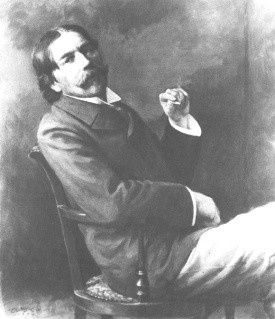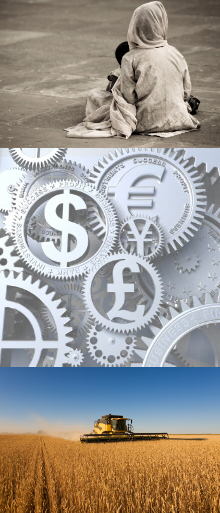Before progressing with this article it is best to define what is meant by endogenous and exogenous money in the context of the production, accessibility and consumption supply side model of the economy (PACM). I will contrast this with the aggregate demand model of the economy (ADM) later.
Endogenous means of exchange
Endogenous means of exchange are goods, services and money that have been created within the production and services sectors in response to the consumption needs of the population whose purchasing power is equal to the value of the receipts of owners, employees of companies and self-employed individuals paid to them for their efforts and work for companies and other individuals.
In terms of transactions of economic goods and services, these can be paid for in kind or in the form of legal tender or close-to-legal tender objects.
Growth in production and consumption within this essentially closed system is through saving and the investment of savings in activities which may improve productivity and as a result end up with more goods and services. If the unit prices of this incremental output are moderated or lowered and wages paid are related in percentage terms to the increase productivity then the real incomes of consumers can rise and real economic growth occurs through in-system innovation.
The way in which savings are transformed into investments can be through a saver agreeing to lend the money in exchange for a fee (interest rate) or else a saver giving the money as an equity contribution to a new activity.
Before defining exogenous means of exchange it is pertinent to raise a relevant concept. Joseph Schumpeter made an important observation that the significance of profit is that it is the guarantee of future activities (through investment) and of future employment (through a rational choice of technologies). This has been cited by Peter Drucker in a paper published in Forbes in 1983 (see Schumpeter and Keynes). If this became the exclusive purpose of profits then the Marxist analysis concerning excess production would have no basis in fact. This rationale supports what I have referred to as the profit paradox in that this aspect of Schumpeter's view is at odds with current concepts of the role of profit. The concept of profit is poorly defined and its role divisive in terms of the operational efficiency and transparency of the economy. In my opinion, limiting the role of profit to the aspects expressed by Schumpeter's observation is entirely valid and it opens a doorway to the resolution of this confused resource allocation issue that circulates around profit. This is achieved by substituting the quest for profits by a quest for real incomes. I will return to these in more detail later in this article.
Exogenous means of exchangeExogenous means of exchange are goods, services and money that have been created outside the production and services sectors. The main form this has taken historically and currently is money that is provided in exchange for a fee. The reason this is classified as being exogenous is that the amount of money entering this type of transaction (debt) can exceed the value of production in the goods, and service production sectors. It therefore represents a growth in the money available as has been explained in the Bank of England note of 2014.
It used to have some relationship to endogenous funds such as savings under the fractional reserve banking system but still represented

Thorstein Bunde Veblen
(1857-1929) |
|
|
more money that was available in savings accounts. Other monies purchased of international financial exchanges has no relationship to savings.
Psychological dimensionsThorstein Veblen made extremely perceptive remarks concerning finance which as far back as 1921 he wrote:
"Half a century ago it was still possible to construe the average business manager in industry as an agent occupied with the superintendence of the mechanical processes involved in the production of goods and services. But in the later development the connection between the business manager and the mechanical processes, has on average, grown more remote; so much so, that his superintendence of the plant or of the processes is frequently visible only to the scientific imagination... His superintendence is a superintendence of the pecuniary affairs of the concern, rather than of the industrial plant; especially is this true in the higher development of the modern captain of industry." |
Veblen was referring to the early consolidation of finance which was a significant factor in the 1929 crash since this was caused by a fixation with values of shares without any attention being paid to the more relevant issues of the actual performance of the companies whose shares were being traded. In Veblen's terms there was no interest in the quality of the
"superintendence of the mechanical processes involved in the production of goods and services". After all, the exponential rise in share prices was exogenous money largely supplied by exogenous provisions in the form of bank loans. The purchase of shares was by speculators and the massive rise in the value of the stock market did not go to the companies but was a cumulating pyramid, or Ponzi scheme driven by exogenous finance. It is, of course true that loans were secured against collateral, so what happened after the Crash is instructive. A large proportion of exogenous sourced fund contracts (debt) resulted in families, and those companies who might have been trading shares, losing the assets put up as collateral. As is well know, banks and many businesses failed, unemployment rose and a depression followed.
The other trend through the 1960s, and still in full swing now, was the purchasing of companies by financial groups, somewhat like commodities, only to asset strip and sell them off with no particular interest in the prospects and wellbeing of the hundreds, and sometimes thousands of people losing their employment. Shareholder value and executive bonuses became more closely associated with financialization in the 1970 with Black and Scholes derivatives trading model which depended upon ever rising financial values of options and derivatives as assets to minimize risk. This culminated in 2008 in the sub-prime mortgage fiasco.
ObservationsWithout exogenous finance it would have been difficult for the 1929 Crash to occur or, at least, if one had occurred the damage would have been far less disruptive that what took place. The same its true of the 2008 financial crisis.
The track record of exogenous finance is not good. Under financialization the Schumpeter view of the role of profit as a guarantor of future activities and or future employment has been vandalized by exogenous finance dealings.
Economic growthToday economic growth has shifted from any notions of endogenous innovation in technology and technique to raise real output to being simply equated with the use of additional "finance", which means debt, to increase "aggregate demand". After more than a decade under quantitative easing (QE), a mega-exogenous scheme, endogenous savings have been destroyed and few alternative financial sources for investment in growth exist. This is because much of the low interest loans have flowed into assets rather than through to productive investment, the ability lower to unit output prices or raise wages. Productivity, real wages and even nominal growth in the production and service sectors have declined progressively for some 30 years, a process intensified by QE. This monetary policy is based on a flawed monetary model in the form of the Quantity Theory of Money (QTM) which has key determinants missing from its equation. An explanation of why the QTM, and QE are flawed can be found in the pdf, available on this site,
"A Real Theory of Money".
During the whole of this prolonged period of financialization the terms of trade between financial intermediaries and banks, on the one hand, and the productive sectors, on the other, have shifted significantly and obviously in favour of financial intermediaries and banks. The incomes and wealth of the financial intermediation and banking sectors has outstripped inflation many times over while the nominal target of 2% inflation under monetary policy has created a currency devaluation treadmill of around 18% each decade, eroding purchasing power for consumers and the productive sector combined. The pound of today is worth less than 1% of the pound in 1945 as a direct result of monetary (exogenous finance) policies.
Since these trends are well documented it is apparent that the process of policy formulation and public choice are defective because many in corporate sectors and constituents have been losing out as a result of:
- risks associated with any exogenous finance contracts linked to production activities
- low risks associated with low interest exogenous finance being diverted from productive sector use into the purchase of assets
- falling real incomes of employees and stagnating real consumption
- rising shareholder value linked to share options whose value has been raised through share buy backs using cheap exogenous finance
- the destruction of endogenous savings as a result of minimal base rates and macroeconomic policies favouring the growth of exogenous financial intermediaries and banks
the investment of exogenous finance in land, real estate, shares and precious metals has resulted in the prices of housing and shares to rise to levels beyond the ever diminishing means of wage earners
All of this calamity is a result of a flawed decision analysis model (QTM) and what constitutes an irrational "policy logic". There is nothing here that reflects some sophisticated financial engineering brilliance in the service of the country but rather, it constitutes a widespread plunder of the productive economy and wellbeing of the people of this country by a few who are favoured by a constitutionally inept and irresponsible policy.
An economy's capacity and evolutionReturning to Veblen's pertinent question,
"Why is economics not an evolutionary science" there is a slow recognition, judging from government responses to the issue that somehow our survival is related to the condition of the natural environment. Policies are required to prevent the current phases of the evolution of our economic affairs be the agent of destruction of the prospects of future generations.

This can only be achieved by not applying policies that provide incentives for more and more production as a measure of economic success and growth based on the Aggregate Demand Model.
In 2015, the United Nations launched Agenda 2015 with 17 Sustainable Development Goals (SDGs) subject to around 230 indicators. Three of the key Sustainable Development Goals have turned out to be negatively correlated to "demand led" economic "growth". These are:
- Sustainable Development Goal 10 - Reduced inequalities
- Sustainable Development Goal 12 - Responsible consumption and production
- Sustainable Development Goal 13 - Climate action
In simple terms demand management of economies based on exogenous fund growth is resulting in increasing disparities in incomes (undermining SDG 10) and the technologies and techniques applied in most supply chains (SDG 12) are not sustainable and as a result SDG 13 or improvements in the state of the climate continues to move in the wrong direction. Policy makers seem to forget that part of the natural environment and ecosystem flora and fauna are the human constituents of the country and their conditions are getting measurably worse as a direct result of inappropriate policies. The fact that older generations appear to be better off than younger generations is not some reflection of greed or selfishness on their part but, rather, the result of policies which have progressively removed the range of options available to constituents in exercising their freedom of pursuit of their interests without inhibiting the freedom of others to do the same. Policies have progressively constrained this freedom of the majority while opening up the freedom of a small minority to withdraw financial resources, more or less at will, from the majority of the population.

In ecological terms such predator-prey scenarios usually result in the draining of sustenance from the predator with the collapse of that particular relationship, and in our case, the economy and perhaps planetary survival for the human race.
Economic growth needs to be based on the innovative capabilities of the supply side and real production sectors to generate useful output while reducing the consumption of natural resources. In other words the economic capacity needs to equate with the natural carrying capacity of the environment. Demand led exogenous finance growth can never achieve this because the incentives create the chaos described above.
We need to invest in an evolutionary approach to the economy that takes advantage of the known facts that 80% of real economic growth come from changes in technologies and techniques, as a result of learning and the accumulation of explicit and tacit knowledge
leading to innovation to change our patterns of consumption and behaviour. Policies need to be reoriented towards these ends. The Real Income Approach and the Production, Accessibility and Consumption Model of the economy is a reasonable starting point to get us ahead of the absurd notion of demand led growth using exogenous finance.
1 Hector McNeill is the Director of SEEL-Systems Engineering Economics Lab.